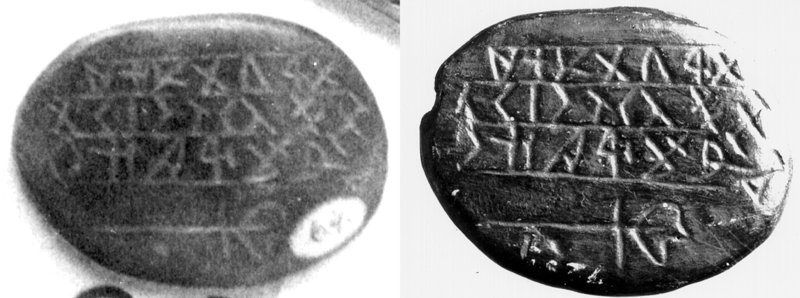
This flat, polished sandstone pebble was found in a 2,000-year-old burial mound in West Virginia in 1838. Though it seemed to bear 25 pseudo-alphabetic characters, no one could agree on their meaning. In 1845 ethnologist Henry Rowe Schoolcraft consulted “noted antiquarians” and concluded that the inscription contains “four characters corresponding to the Ancient Greek; four Etruscan; five Runic; six ancient Gallic; seven old Erse; ten Phoenician; fourteen old British; sixteen Celtiberic, with some resemblance to the Hebrew.” In the 1870s physician R.J. Farquharson compiled wildly varying translations of the inscription from three different scholars:
- “Thy orders are laws, thou shines in thy impetuous clan, and rapid as the chamois.”
- “The chief of emigration who reached these places (or island), has fixed these decrees forever.”
- “The grave of one who was murdered here; to revenge him may God strike his murderer, suddenly taking away his existence.”
Also in the 1870s, antiquarian M.C. Reid asked a law student, a schoolgirl, a pharmacist, and a college professor to create “twenty or more arbitrary characters not resembling any figures or alphabetical characters known to them.” Their characters resembled those in Old World alphabets, just as did those on the Grave Creek stone. Reid was “compelled to conclude that there is nothing in the form of the characters of the Grave Creek Stone which require us to decide that they are old, that they are alphabetical, or if alphabetical that they are derived from any known alphabet.”
Today it seems most likely that the stone was forged by James W. Clemens, a local physician who had financed the original excavation and wanted to sell rights to exploit the mound. In 2008 anthropologist David Oestreicher discovered the same sequences of markings in a 1752 book by a Spanish historian, An Essay on the Alphabets of the Unknown Letters That Are Found in the Most Ancient Coins and Monuments of Spain. It appears that Clemens simply copied these characters onto the stone and planted it in the mound.
